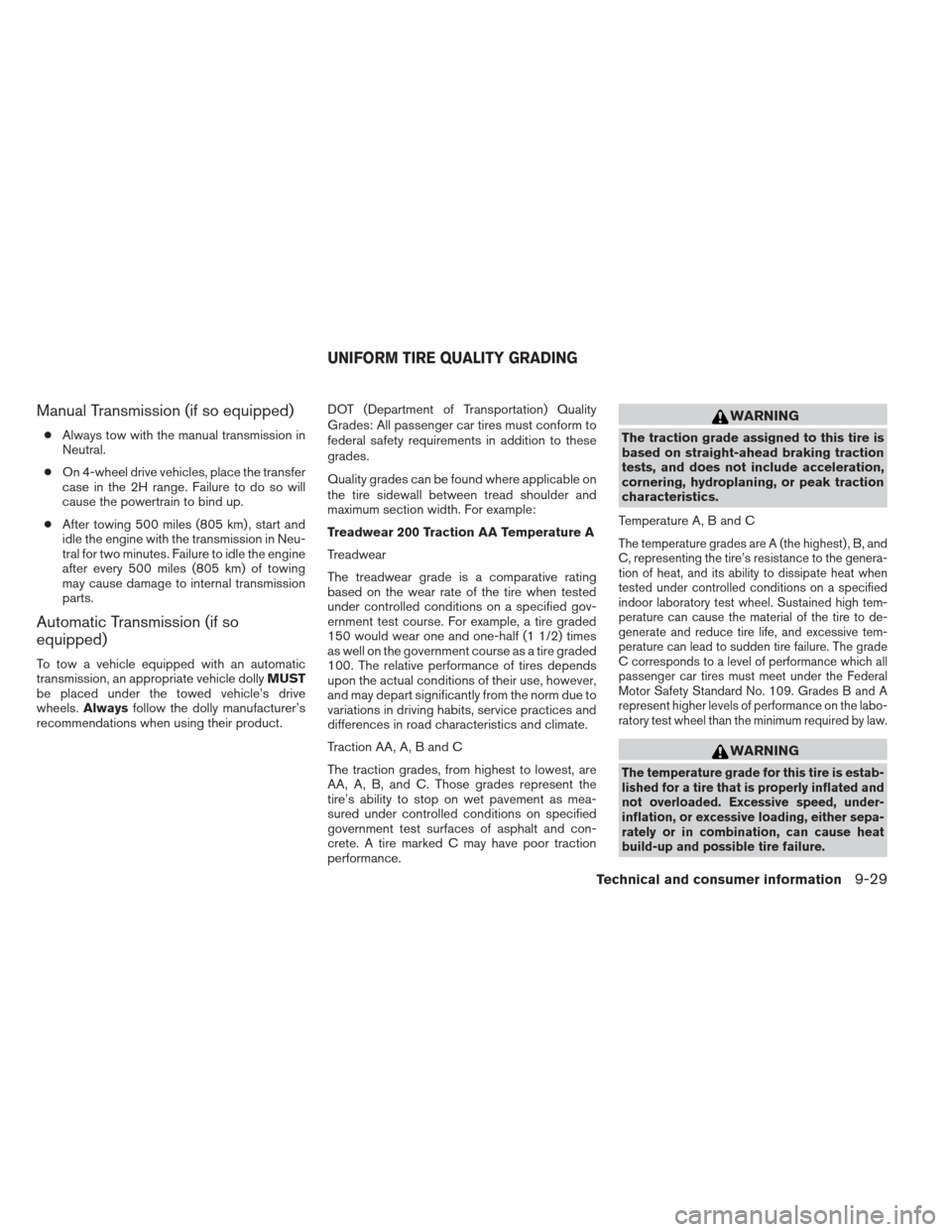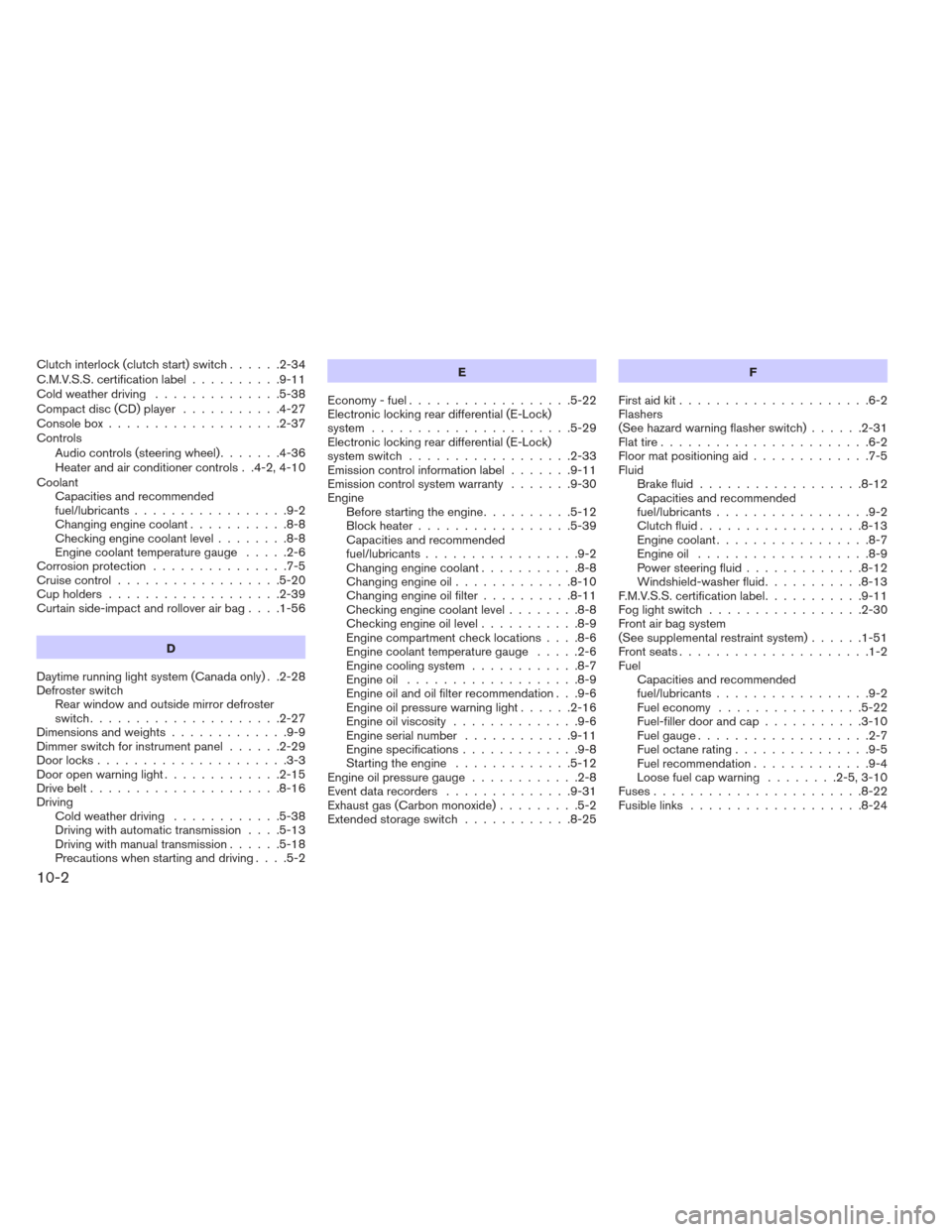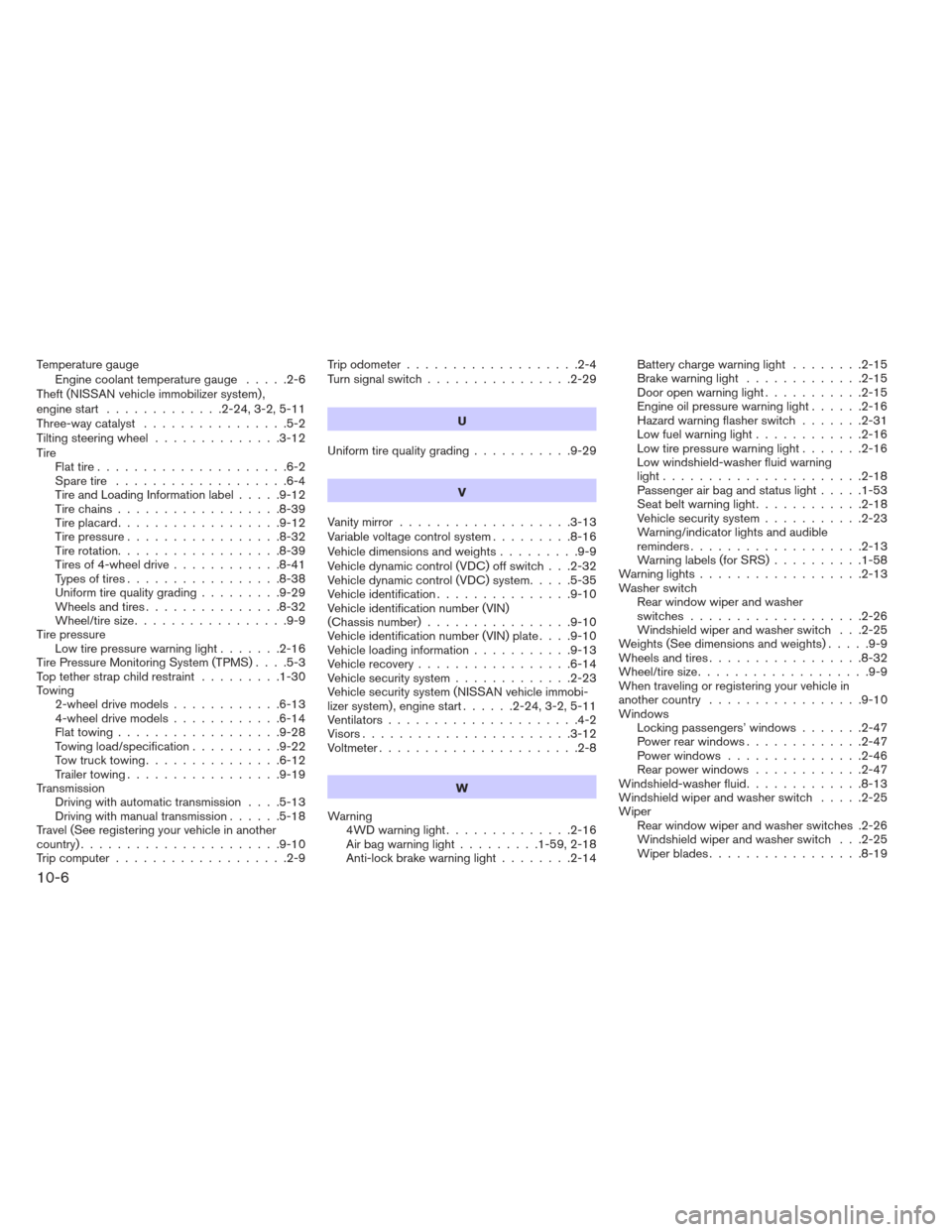2012 NISSAN XTERRA flat tire
[x] Cancel search: flat tirePage 330 of 341

Manual Transmission (if so equipped)
●Always tow with the manual transmission in
Neutral.
● On 4-wheel drive vehicles, place the transfer
case in the 2H range. Failure to do so will
cause the powertrain to bind up.
● After towing 500 miles (805 km) , start and
idle the engine with the transmission in Neu-
tral for two minutes. Failure to idle the engine
after every 500 miles (805 km) of towing
may cause damage to internal transmission
parts.
Automatic Transmission (if so
equipped)
To tow a vehicle equipped with an automatic
transmission, an appropriate vehicle dolly MUST
be placed under the towed vehicle’s drive
wheels. Always follow the dolly manufacturer’s
recommendations when using their product. DOT (Department of Transportation) Quality
Grades: All passenger car tires must conform to
federal safety requirements in addition to these
grades.
Quality grades can be found where applicable on
the tire sidewall between tread shoulder and
maximum section width. For example:
Treadwear 200 Traction AA Temperature A
Treadwear
The treadwear grade is a comparative rating
based on the wear rate of the tire when tested
under controlled conditions on a specified gov-
ernment test course. For example, a tire graded
150 would wear one and one-half (1 1/2) times
as well on the government course as a tire graded
100. The relative performance of tires depends
upon the actual conditions of their use, however,
and may depart significantly from the norm due to
variations in driving habits, service practices and
differences in road characteristics and climate.
Traction AA, A, B and C
The traction grades, from highest to lowest, are
AA, A, B, and C. Those grades represent the
tire’s ability to stop on wet pavement as mea-
sured under controlled conditions on specified
government test surfaces of asphalt and con-
crete. A tire marked C may have poor traction
performance.
WARNING
The traction grade assigned to this tire is
based on straight-ahead braking traction
tests, and does not include acceleration,
cornering, hydroplaning, or peak traction
characteristics.
Temperature A, B and C
The temperature grades are A (the highest) , B, and
C, representing the tire’s resistance to the genera-
tion of heat, and its ability to dissipate heat when
tested under controlled conditions on a specified
indoor laboratory test wheel. Sustained high tem-
perature can cause the material of the tire to de-
generate and reduce tire life, and excessive tem-
perature can lead to sudden tire failure. The grade
C corresponds to a level of performance which all
passenger car tires must meet under the Federal
Motor Safety Standard No. 109. Grades B and A
represent higher levels of performance on the labo-
ratory test wheel than the minimum required by law.
WARNING
The temperature grade for this tire is estab-
lished for a tire that is properly inflated and
not overloaded. Excessive speed, under-
inflation, or excessive loading, either sepa-
rately or in combination, can cause heat
build-up and possible tire failure.
UNIFORM TIRE QUALITY GRADING
Technical and consumer information9-29
Page 335 of 341

Clutchinterlock(clutchstart)switch......2-34
C.M.V.S.S. certification label..........9-11
Cold weather driving ..............5-38
Compact disc (CD) player ...........4-27
Console box ...................2-37
Controls Audiocontrols(steeringwheel).......4-36
Heater and air conditioner controls . .4-2, 4-10
Coolant Capacities and recommended
fuel/lubricants .................9-2
Changing engine coolant ...........8-8
Checking engine coolant level ........8-8
Engine coolant temperature gauge .....2-6
Corrosionprotection ...............7-5
Cruise control ..................5-20
Cupholders...................2-39
Curtain side-impact and rollover air bag ....1-56
D
Daytime running light system (Canada only) . .2-28
Defroster switch Rear window and outside mirror defroster
switch.....................2-27
Dimensionsandweights.............9-9
Dimmer switch for instrument panel ......2-29
Door locks .....................3-3
Door open warning light .............2-15
Drive belt .....................8-16
Driving Cold weather driving ............5-38
Driving with automatic transmission ....5-13
Driving with manual transmission ......5-18
Precautions when starting and driving ....5-2 E
Economy - fuel ..................5-22
Electronic locking rear differential (E-Lock)
system ......................5-29
Electronic locking rear differential (E-Lock)
system switch ..................2-33
Emission control information label .......9-11
Emission control system warranty .......9-30
Engine Before starting the engine ..........5-12
Block heater .................5-39
Capacities and recommended
fuel/lubricants .................9-2
Changing engine coolant ...........8-8
Changing engine oil .............8-10
Changing engine oil filter ..........8-11
Checking engine coolant level ........8-8
Checking engine oil level ...........8-9
Engine compartment check locations ....8-6
Engine coolant temperature gauge .....2-6
Engine cooling system ............8-7
Engineoil ...................8-9
Engine oil and oil filter recommendation . . .9-6
Engine oil pressure warning light ......2-16
Engine oil viscosity ..............9-6
Engine serial number ............9-11
Engine specifications .............9-8
Starting the engine .............5-12
Engine oil pressure gauge ............2-8
Eventdatarecorders ..............9-31
Exhaust gas (Carbon monoxide) .........5-2
Extended storage switch ............8-25 F
First aid kit .....................6-2
Flashers
(See hazard warning flasher switch) ......2-31
Flat tire .......................6-2
Floor
mat positioning aid .............7-5
Fluid Brake fluid ..................8-12
Capacities and recommended
fuel/lubricants .................9-2
Clutch fluid ..................8-13
Engine coolant .................8-7
Engine oil ...................8-9
Power steering fluid .............8-12
Windshield-washer fluid ...........8-13
F.M.V.S.S. certification label ...........9-11
Foglightswitch .................2-30
Front air bag system
(See supplemental restraint system) ......1-51
Front seats .....................1-2
Fuel Capacities and recommended
fuel/lubricants .................9-2
Fuel economy ................5-22
Fuel-filler door and cap ...........3-10
Fuelgauge...................2-7
Fuel octane rating ...............9-5
Fuel recommendation .............9-4
Loose fuel cap warning ........2-5,3-10
Fuses.......................8-22
Fusiblelinks ...................8-24
10-2
Page 339 of 341

Temperature gaugeEngine coolant temperature gauge .....2-6
Theft (NISSAN vehicle immobilizer system) ,
engine start .............2-24,3-2,5-11
Three-way catalyst ................5-2
Tilting steering wheel ..............3-12
Tire Flat tire .....................6-2
Spare tire ...................6-4
Tire and Loading Information label .....9-12
Tire chains ..................8-39
Tireplacard..................9-12
Tirepressure.................8-32
Tire rotation..................8-39
Tires of 4-wheel drive ............8-41
Types of tires .................8-38
Uniform tire quality grading .........9-29
Wheels and tires ...............8-32
Wheel/tire size .................9-9
Tire pressure Low tire pressure warning light .......2-16
Tire Pressure Monitoring System (TPMS) ....5-3
Top tether strap child restraint .........1-30
Towing 2-wheel drive models ............6-13
4-wheel drive models ............6-14
Flattowing..................9-28
Towingload/specification..........9-22
Towtrucktowing...............6-12
Trailertowing.................9-19
Transmission Driving with automatic transmission ....5-13
Driving with manual transmission ......5-18
Travel (See registering your vehicle in another
country) ......................9-10
Trip computer ...................2-9 Trip odometer
...................2-4
Turn signal switch ................2-29
U
Uniform tire quality grading ...........9-29
V
Vanity mirror ...................3-13
Variable voltage control system .........8-16
Vehicle dimensions and weights .........9-9
Vehicle dynamic control (VDC) off switch . . .2-32
Vehicle dynamic control (VDC) system .....5-35
Vehicle identification ...............9-10
Vehicle identification number (VIN)
(Chassis number) ................9-10
Vehicle identification number (VIN) plate ....9-10
Vehicle loading information ...........9-13
Vehicle recovery .................6-14
Vehicle security system .............2-23
Vehicle security system (NISSAN vehicle immobi-
lizer system) , engine start ......2-24,3-2,5-11
Ventilators .....................4-2
Visors.......................3-12
Voltmeter......................2-8
W
Warning 4WDwarninglight..............2-16
Air bag warning light .........1-59,2-18
Anti-lock brake warning light ........2-14Battery charge warning light
........2-15
Brake warning light .............2-15
Door open warning light ...........2-15
Engine oil pressure warning light ......2-16
Hazard warning flasher switch .......2-31
Low
fuel warning light ............2-16
Low tire pressure warning light .......2-16
Low windshield-washer fluid warning
light......................2-18
Passenger air bag and status light .....1-53
Seatbeltwarninglight............2-18
Vehicle security system ...........2-23
Warning/indicator lights and audible
reminders...................2-13
Warning labels (for SRS) ..........1-58
Warninglights..................2-13
Washer switch Rear window wiper and washer
switches...................2-26
Windshield wiper and washer switch . . .2-25
Weights (See dimensions and weights) .....9-9
Wheels and tires .................8-32
Wheel/tire size ...................9-9
When traveling or registering your vehicle in
anothercountry .................9-10
Windows Locking passengers’ windows .......2-47
Power rear windows .............2-47
Power windows ...............2-46
Rear power windows ............2-47
Windshield-washer fluid .............8-13
Windshield wiper and washer switch .....2-25
Wiper Rear window wiper and washer switches .2-26
Windshield wiper and washer switch . . .2-25
Wiperblades.................8-19
10-6